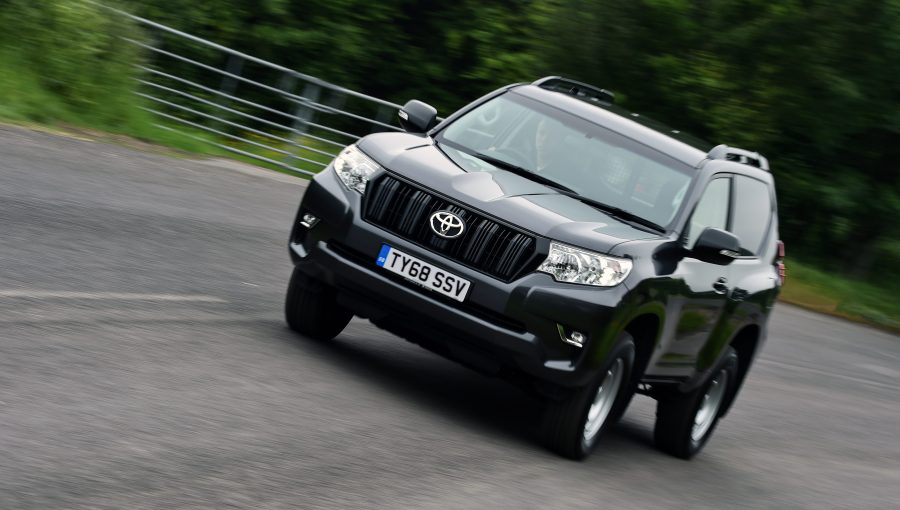Although Toyota’s passenger car range is predominantly focused around petrol-electric hybrid powertrains, the Land Cruiser, Hilux and Proace models are fitted with diesel engines. A diesel particulate filter (DPF) is a feature of these models, and you may have heard about the need for regular DPF regeneration. What does this component do and how do you take care of it?
What does a diesel particulate filter (DPF) do?
The DPF is fitted within the exhaust system and is designed to catch soot particles and nitrous oxide (NOx) from the combustion process that would otherwise be released into the atmosphere. The DPF is highly effective and traps around 80% of these harmful particulates.

Why do modern diesel engines need a DPF?
European legislation places strict exhaust emissions targets on all vehicle manufacturers. From September 2009, the Euro 5 legislative standard came into effect, part of which required all diesel cars registered from that point on to be equipped with a diesel particulate filter, or DPF.
These filters are used throughout the industry in all diesel-powered passenger vehicles, and their efficiency is vital now that stringent Euro 6d emissions standards are in force.
Do I need to replace a DPF during normal servicing?
Diesel particulate filters do have a capacity limit and can become full. But unlike traditional air, oil or pollen filters that need to be exchanged manually at regular intervals, the DPF has a much longer service life and is designed to regenerate to restore its performance.
The car’s electronic control unit (ECU) is programmed to do this automatically, neutralising the soot by burning it off at high temperature within the exhaust system while the vehicle is running. All modern cars with diesel engines follow this procedure.

How does DPF regeneration occur?
The regeneration occurs automatically, usually without the driver being aware that it is taking place. In the majority of cases, the process is carried out when the engine and exhaust system has reached normal operating temperature and the vehicle is travelling at over 40mph.
However, if your driving is limited to urban areas, the low speeds and frequent stops mean the conditions for normal regeneration do not exist. In these instances, the ECU monitors the accumulation of soot and instructs an alternative regeneration programme to begin well before the filter becomes saturated.
This programme injects small quantities of fuel into the engine after combustion, which increases the temperature within the exhaust system and creates an environment where it is possible to safely burn off the soot.
This method is very successful within the small percentage of vehicles where normal regeneration is not possible. However, due to the nature of city traffic, the regeneration process can be interrupted when the vehicle completes its short journey and is turned off. If this occurs, the ECU is programmed to recommence the process when the engine is restarted and back up to temperature again.

How can I help prevent DPF blockages in my Toyota?
Follow these four simple actions:
1. Regularly drive your Toyota on highways at speeds of between 40-55mph for around 20-30 minutes.
2. Avoid spending unnecessary amounts of time with the engine idling.
3, Try to limit the frequency of short journeys where the engine is running for less than ten minutes.
4. Do not ignore dashboard alerts related to the DPF.
Will I be warned if all DPF regeneration processes have been unsuccessful?
Very occasionally, use of the vehicle might be such that it will have been impossible for the ECU to complete the administration of any regeneration procedure. At this point, the DPF will have become overloaded and stopped functioning, so your Toyota will illuminate a warning light in the dashboard. It will then be necessary for the soot to be neutralised and the filter regenerated manually at a main dealer.
It is extremely unwise to ignore this visual warning as the DPF can become irreparably damaged. What’s more, it is illegal to remove the filter entirely.
Learn more: What is the exhaust gas recirculation valve and what does it do?





a light on the dash would be handy when is regen is on or a % symbol how full it is , this could be done as software update may be? ? iv tried 2 talk two toyota thay don’t seam two want two know or listen
Hi Ken
Thanks for your post and feedback.
We will pass this information back to the product team who look after our product specification. While we do not have current plans to introduce this feature, it would require new parts to be incorporated rather than a software update, we can review this for the future.
Thanks again for your post.
Please, where can i get a brand new dpf to buy? I have removed my existing dpf because it has clogged to the extent that the filter elements are burnt. The car now emits white smoke when engine gets hot especially when idle in traffic.
Hi Dawn,
Thank you for getting in touch.
We would advise that you visit your local dealer as they will be equipped to deal with this for you.
In order to find your local dealer please click on the following link: https://www.toyota.co.uk/find-your-dealer
We hope you find this helpful.
Thanks.
Does this same procedure apply to older diesels (2010). Do they also have the fuel injection process that allows regeneration for city driving?
Hi Stu
Thanks for your post.
When Euro 5 came into effect in September 2009, part of it required all diesel cars registered from that point on to be equipped with a diesel particulate filter, or DPF. However we need more vehicle details in order to confirm a specific model. Hope this helps.
What is the capacity limit of a DPF, and at what point can you, or should you expect to start having problems with it?
You state above that the DPF has a much longer service life and is designed to be regenerated to restore its performance, but what happens if/when the filter is regenerated manually at a main dealer and the ECU warning light remains lit up on the dashboard?
What is the life span of a DPF and at what mileage should you expect to have issues with it before any suggestion of a new DPF has to be installed?
Why have you removed the post i made about DPF’s instead of answering it?
What is your problem? What are you trying to cover up?
I will be taking this matter to FOS and other authorities!
Hello Steven
We have not removed your post. All comments received on our Blog need to be approved before they are published and can be seen. Your post was received at 14.39 today and will be published as soon as we have received a reply from our technical team.
OK thanks. When i checked for a staus update earlier my initial comment was missing so it appeared to have been deleted.
This is an astonishingly frustrating process. I have been told a number of times that I need to run my car for longer distances so this doesn’t happen. It seems I am expected to create the right conditions for my car to be both efficient and safe rather than a car working efficiently and safely for me! I find this totally unacceptable. I have an additional problem of too much oil presenting on the dipstick after this “regen”. This definitely makes my car unsafe to drive! This has happened to me twice in as many months. Am losing faith and confidence in the car and its issues.
Hi Shena,
Thank you for your post. Sorry to hear of your disappointment. We can confirm that the regeneration will not cause excess oil to appear on the dipstick as the amount of oil in your engine will be governed by the amount of oil put in. If you are concerned about this we advise that you contact your local Toyota dealer, who can check this further. You can find your local Toyota dealer here: https://www.toyota.co.uk/world-of-toyota/find-your-dealer.json.
Hope this helps and if you have any other questions please let us know.
No. The oil on the dipstick in excess is a separate problem. I am repeatedly being advised that I need to run my car more often/for longer drives/at faster speeds to minimise regeneration. This is not a realistic expectation, nor economical. It does not solve anything for myself as driver. So, it seems still need to create the right conditions for the car and be responsible for that. Do petrol cars have these issues?
Hi, I’m having trouble with the DPF on my avensis this car is 13 months old ,can you clarify the warranty period on this please .
That comment is not true. Diesel will enter the sump and raise the level on the dipstick. I have a Toyota Yaris diesel and it happens to me. Short journey’s where the engine is not reaching the correct temperature will result in extra fuel being sent to the filter in an attempt burn off any soot accumulated. All excess fuel will enter the sump. A diesel engine since 2009 has these DPF filters fitted and aren’t suited to short journey’s. They are only any good if you drive on long journeys.
Unfortunately the dealership who sold me the car never told me that or I wouldn’t have bought it
Hi Shena,
Thank you for your quick reply. Sorry for any misunderstanding. Hopefully the dealership is addressing the issue with the excess oil on the dipstick. We can confirm that petrol cars do not have these issues of a DPF. If we can help in any other way please let us know.
Hi Stewart,
Thank you for your post. We would advise if you are having issues with your car to visit your local Toyota Dealer: https://www.toyota.co.uk/world-of-toyota/find-your-dealer.json. Toyota warranty is design to cover any manufacturing defect. Your local Toyota Dealer will be able to investigate the issue further for you. Hope this helps clarify and if you have any more questions please let us know.
Is the dpf covered under warranty
Hi Alan,
Thank you for your post. The DPF is not covered under warranty due to this being a serviceable part. Hope this helps and if you have any other questions please let us know.
Hi, how much does a replacement DPF filter cost? Thanks
Hi Tammy,
Thank you for your post. The cost of a DPF filter differs from model to model. We would advise contacting your local Toyota dealer with your chassis number and vehicle details. From this they will be able to offer you a price specific to your model car. Hope this helps and if you have any other questions please let us know.
Hi, How long I need to drive (a range will be fine) before the DPF needs regeneration. For example, If I am doing short trips of 4-5 miles twice a day within city for four weeks (250-300miles) and then do a long trip where I can drive over 40mph for more than 10 min. Will this result in clogging?
Thanks
Hi Ramana,
Thank you for your post. We have spoken with our technical department and they have advised that this type of driving style will result in clogging. Hope this helps and if you have any further questions please let us know.